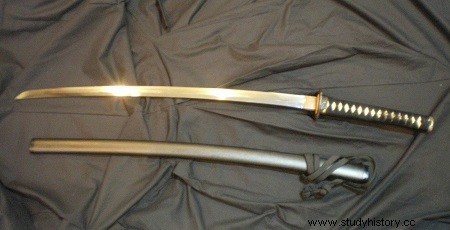
Symbol of the samurai caste, the katana is a saber (curved blade with a single edge) of more than 60 cm. It is worn slipped into the belt, cutting edge pointing upwards at the left side of the belt (downwards also if the wearer is a rider). The wakizashi-katana set is called the daisho. Some periods of Japanese history being calmer, the katana had more of a ceremonial role than a real weapon. The katana is a weapon of size (of which the edge is used) and of thrust (of which the point is used).
By extension, the term katana is often used to refer to all Japanese swords (Tachi, Uchigatana, etc.)
Its production exceeded that of the tachi during the Muromachi period (after 1392).
The katana is a curved nihonto (Japanese sword) that is worn slipped into the obi (belt) edged upwards, unlike the tachi, the cavalry sword.
The katana has a size (blade) greater than two shakus (30.2 cm x2) or 60 cm but this length can vary according to the periods and techniques of war. It is usually wielded with two hands, but some techniques, such as Musashi Miyamoto's two-sword technique, or techniques involving the use of the scabbard, require one-handed use. Its grip (tsuka), depending on the political climate, varied between the width of two or three hands. The tsuka begins with a guard (tsuba) that protects the hand, and ends with an end used for striking (tsuka-gashira or kashira). The weight of a standard katana varies from 800 grams to 1,300 grams.
Manufacturing
Finished in bevel, the blade of the katana is traditionally forged from raw steel transformed into composite steel. Hard for the envelope, and softer for the core. They are each laminated many times, then intimately welded together in the forge. Then, covering the back and the sides with a clay mixture, the blade undergoes a selective hardening, which will give the weapon the combined qualities of extreme hardness of the cutting edge, as well as resistance to shocks for the whole .
The next step is polishing, carried out using volcanic stones with decreasing grain, which sharpens the blade revealing the crystalline structures.
Presentation
When the katana is on its display stand, katana kake, it is placed:
in its sheath (saya);
edged upwards;
public face (omote) visible, "Tsuka" on the left;
to the left of you.
Most often, only the "mount" or koshirae of the sword is exposed in this way (tsuka, tsuba and saya, held together by a wooden blade, the tsunagi). Indeed the blade is often stored in an airtight white wooden protective frame called shirasaya (white sheath) (which are not intended for combat).
In times of peace, the katana is placed on the display, the tsuka on the left side, while in times of war, the tsuka is on the right, in order to allow a faster exit of the katana in case of danger.
